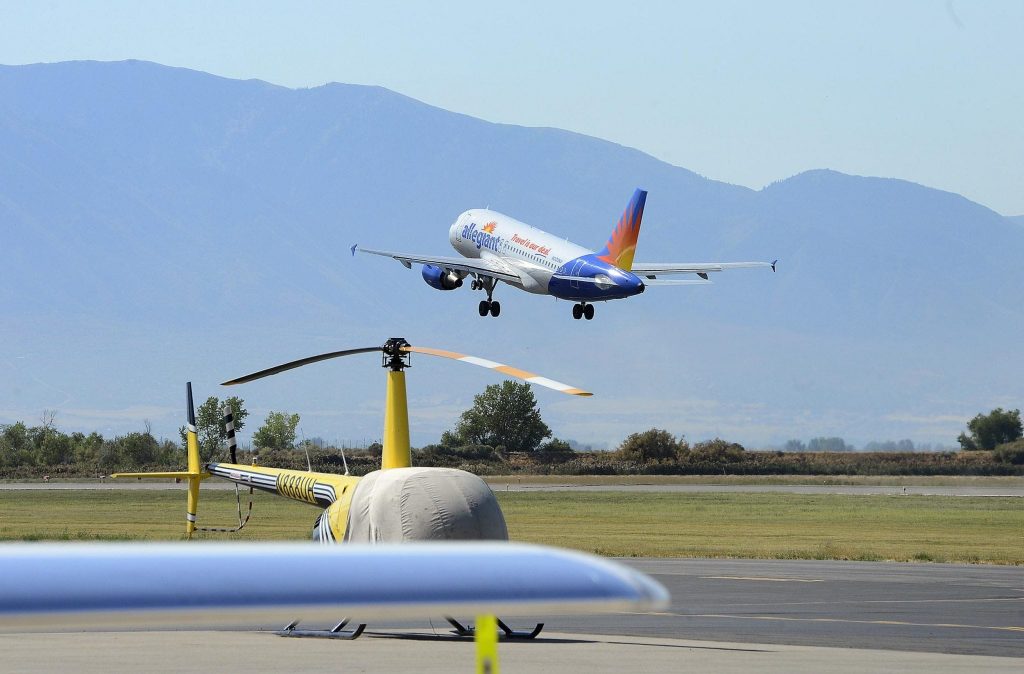Low-Cost Carrier Allegiant Seeks Permission to Fly to Mexico, Finally

Skift Take
Around Allegiant Air the question of when the airline might fly to Mexico has become a running joke. Since Andrew Levy was its president — he left in 2014 — executives at the discount carrier have suggested international expansion was in the plans.
Yet the airline kept putting it off. Allegiant had many opportunities in the United States, Levy and his successors said, and the timing was not right. In late 2017, an Allegiant executive told Skift the route planners knew where in Mexico they wanted the airline to fly, but were waiting for others to update the carrier's technological infrastructure.
Now Allegiant, one of three ultra-low-cost U.S. airlines, may be ready. On Monday, it filed with the U.S. Department of Transportation, asking for permission to fly between the United States and Mexico.
Allegiant has not said where it will fly, or when it might start service. Before it launches flights, it will need permission from the U.S. and Mexican governments.
"Today’s filing is the first step in a multi-step process, but we’re excited for the opportunity to offer our customers affordable airfare to Mexico," Allegiant spokeswoman Sonya Padgett said Monday in an email.
Here's our take on what Allegiant may be planning, and how it affects travelers.
Why now?
Allegiant Air has reported 64 consecutive profitable quarters by following a simple strategy: It seeks routes with little or no competition.
Mostly, it takes passengers from small- and medium-size cities — think Omaha, Nebraska, Idaho Falls, Idaho, and Minot, North Dakota — to Las Vegas, Phoenix, and several cities in Florida.
More recently Allegiant has added flights between mid-size cities. But the strategy is similar, with planners looking for underserved routes that may interest leisure travelers. Allegiant is the only airline flying between Memphis and Austin, Texas, for example.
Within the United States, this strategy can only take Allegiant so far. In the past five years, Allegiant has grown, adding some of the most obvious underserved routes. Meanwhile, other airlines have copied Allegiant’s approach, realizing there’s money in smaller markets.
Spirit has probably been most aggressive in adding Allegiant-style routes.
Until former CEO Ben Baldanza left Spirit in early 2016, the discounter was focused on flying between the biggest U.S. cities, like Los Angeles to Chicago, scooping up travelers who didn’t want to pay legacy airline pricing. Spirit still flies big city routes, but under new management, it has been diversifying with smaller markets.
With Allegiant running out of obvious U.S. city pairs, it makes sense for the airline to go abroad. It probably hopes the same smaller-town passengers that love Las Vegas or Orlando will want to visit Mexican beaches, if given a chance to fly nonstop.
What About Fleet?
It’s probably a factor, too.
When Allegiant executives started speaking about Mexico, the airline’s fleet was dominated by older and less reliable MD-80 aircraft. Last year, the airline retired its final MD-80, replacing the jets with newer Airbus A319s and Airbus A320s.
The aircraft break less often, giving the airline more confidence in its abilities to fly to Mexico. The airplanes are also more efficient.
Where might it fly?
We think Allegiant will go big into Mexico’s top beach market — Cancun.
It’s easy to fill planes to Cancun, and the airline probably won’t even have to do much advertising. People in Omaha know the market. They just haven’t been able to (easily) get there. And they haven’t been offered the right prices.
Next, Allegiant probably will look at other popular Mexican beach markets, including Los Cabos and Puerto Vallarta.
As for U.S. markets, Allegiant may look to medium-size cities. Many small markets lack international airports, making Mexico impossible.
Why Won't Allegiant Say More About its Plans?
JetBlue Airways has chutzpah. It won’t fly to Europe until 2021, yet it has already said it will fly to London first.
That excites customers, but it allows other airlines to move to block its progress. Already, Delta Air Lines has said it or partner Virgin Atlantic will fly Boston to London Gatwick by next year.
Allegiant does not want competitors to know its intentions, so it’s not telling the public where it will fly. “Identifying the actual cities we serve will come later in the process,” Padgett said.
Hasn't Allegiant Filed Before?
You have a good memory.
In 2013, the airline made a similar filing, asking for permission to fly from Las Vegas to Hermosillo and Los Cabos. But the carrier never flew the routes.
Allegiant could reverse this time, too. But a lot has changed in the past six years, and Allegiant is probably ready. “Basically, the timing is right,” Padgett said.
What about pricing?
Allegiant charges low base fares, with fees for nearly everything else, including carry-on bags, seat selection, and onboard drinks.
Allegiant’s fares should be considerably lower than the competition’s one-stop options. But we won’t know pricing until tickets go on sale. By law, airlines cannot talk about future fares.
Will Fares to Mexico Fall On Other Airlines?
They probably will not.
Allegiant’s relationship with larger airlines is atypical. The U.S. airline industry is competitive, and most carriers see others as a threat. But larger airlines don’t usually fear Allegiant because of its unusual route network.
If Allegiant sticks with its standard strategy of flying from unserved markets to Mexico, established airlines probably won’t discount fares to match.
This is not going to be a repeat of what’s happening in Hawaii, where many airlines, perhaps spooked by Southwest’s entry, have been lowering fares.
“Allegiant controls a non-threatening network that, given its lack of overlap with most major carriers, has not historically elicited a competitive response,” Joseph DeNardi, an analyst with Stifel, wrote in an April 21 report.
Will This Work?
We won’t know until it flies. But it’s a relatively low risk.
Cancun is not so different than Las Vegas or Orlando, two of Allegiant’s best performers. The airline’s experience in leisure markets should help in Mexico.
On a technical basis, Allegiant doesn’t need much to fly to Mexico. Before it could fly to Hawaii, Southwest spent more than a year petitioning the government to give it ETOPS authority to fly long distances over water. That’s not needed in Mexico.
Also, Allegiant already flies to Mexico with charters, so it has some experience with popular airports.
The biggest risk is probably fares. Other airlines, including the Mexican discounter Volaris, have noted recent softness in Mexico-U.S markets. They have blamed overcapacity, a result of a 2016 treaty between the United States and Mexico that allowed airlines to add more flights to popular destinations. In the past year, some carriers have cut some Mexico-United States flights to try to boost pricing power.
Allegiant may get caught up in this revenue softness. But the issues could disappear once the airline flies there. Or, Allegiant’s routes could be so unusual — smaller cities to Cancun — that the airline will insulate itself from troubles faced by other airlines.




